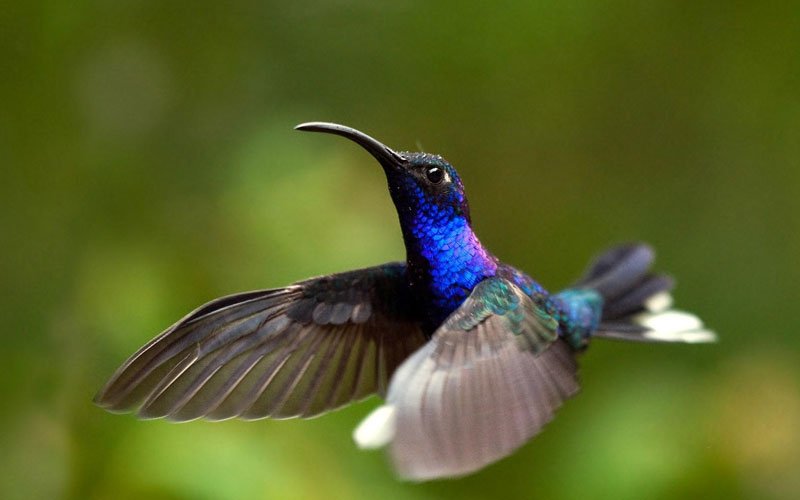Animals generally have a broader lifespan than birds. As per the American Bird Conservancy data, the average lifespan of birds is four years and goes up to 100 years.
Exception: The parrot bird generally comes with a longer lifespan. But what do the smallest birds -hummingbirds do?
Let’s have a close look at the link lifespan of this tinies creature.
How Long Do Hummingbirds Live In Wild
Depending on the species, the hummingbirds live about 3-7 years. Certain factors are responsible for a hummingbird’s lifespan.
Generally, ten years of lifespan is too much for the hummingbirds in the wild. Still, study shows that specific three species of hummingbird can live up to ten years: Buff Bellied Hummingbirds, Black-Chinned Hummingbirds, and Broad Tailed Hummingbirds.
How Long Do Hummingbirds Live In Captivity
The captivity hummingbirds generally live slightly larger than the wild. As in captivity, they are well cared for.
In captivity, the longest-lived hummingbirds were Black-Chinned hummingbirds who lived 13 years in Arizona-Sonora Desert Museum. The reason for this longer lifespan is generally proper protection from predators.
Different Life Stages of Hummingbirds
The life cycle of a hummingbird is generally busy. The female hummingbirds do everything from laying eggs to building nests and caring for their hatchlings. They make hummingbirds generally spend days foraging for food and searching for mates. Here different life stages of hummingbirds are given below:
Hummingbirds Foraging
The hummingbird’s wings beat can range from 10-15 beats. So, they need food to support their constant wings beat.
The hummingbirds generally spend most of their time foraging nectar and insects. They need to support their wings.
Apart from faster wing eating, they also have a faster heart rate of 500-600 times in 1 minute. At the same time, the human has 60-100 times in a minute.
Hummingbird Sizes
The hummingbirds are considered the tiniest hummingbirds. It generally weighs between 0.6 ounces to 0.7 ounces, and the length is 2.41 inches to 2.17 inches.
The adult hummingbird weighs between 0.9 to 0.23 ounces. Their length is 2.4 to 4.72 inches. The average-sized hummingbird can last up to 12 years in its wildlife.
Hummingbirds Courtship
The male hummingbirds are coloured elaborately with attractive long tail feathers to attract the female hummingbirds. These male hummingbirds fly in such a way to display their beautiful plumage.
Some species of hummingbirds are pretty territorial. So they prevent the others from their display grounds.
There are specific species such as
Wedge-tailed Sabrewing who carry display lekking behaviour. That means they tend to group for any flight or songs.
During their mating session, the make and female hummingbirds mate with multiple partners. The female birds can have two broods in a single year. They also get sexually matured at one year.
Hummingbirds Laying Eggs
The female hummingbirds build their nests before laying eggs. Their nests are generally as tiny as a bottle cap. The primary materials used for making these nests are tiny leaves, lichens etc.
After courtship, they lay two white eggs in their tiny nests. These eggs are measured in 0.315 to 0.433 inches.
The female hummingbirds don’t lay two eggs at the same time. They take up to 48 hours to lay her second egg.
The incubation of hummingbirds’ eggs takes 10-19 days. Various essential things affect the incubation, such as different species and other environmental intolerance.
For example, the Ruby-Throated species incubate between 14 days while the Rufous Hummingbirds take 12 days.
Hummingbirds Babies
The hummingbird’s hatchlings ate dependent on their mother until they mature. The tiny hatchlings generally have few to no feathers in their body with closed eyes.
The baby takes 23-26 days to grow up properly. For up to 12 days, their mother maintains their hatchlings’ body temperature.
The mother hummingbirds feed their babies small arthropods and nectar. Once they are eligible enough, they leave the nest.
After leaving, the mother hummingbirds feed their babies for 25 days. Thus they are capable of looking after themselves.
When the fledglings mature enough, the mother hummingbird teaches them how to catch bugs and insects. At that time, the mother hummingbirds also prepare themselves for nest building and laying eggs for the next time.
How Do Most Hummingbirds Die
Generally, most hummingbirds die during the nesting stage. Research shows that 75% of hummingbirds die in their nestling stage.
However, further research on Western Mexico says that their nestling mortality rate is only 26%. The reason for death in the nestling stage is weather and predator attack.
If they survive their nestling stage, mortality risk gets lower than before. The hummingbirds are one of the most adaptable types of birds who accordingly adapt their nesting behaviour as per nature.
Adult hummingbirds can die for many reasons. Those are given below:
Other Reasons for Hummingbirds’ Death
You can find many hummingbird predators. These animals eat up the hummingbirds. Even the other birds might kill hummingbirds if they enter into their territory.
As these birds are so small and unique, they become confused for other animals and get killed accidentally. Here are the specific causes of hummingbirds’ death are given below:
Starvation
Like the other animals, hummingbirds also require a high intake of calories. The hummingbirds need half of their body weight. Sometimes, it gets difficult to keep themselves up with bad weather, changing seasons, etc.
Sometimes the fear of other predators also prevents them from forging food. That means they are always in danger of starving.
Disorder
The hummingbird feeders can be dangerous for those tiny birds if they are not properly cleaned and maintained. Their diet should consist of sugar, and it can ferment if not cleaned or refilled.
If the hummingbirds develop an infection in their system, it can hinder their movement. If the hummingbird can not beat its wings, they have a problem accessing food.
Fungal infection also creates swelling in their tongue. As a result, they can’t eat food properly and die of starvation.
Weather
Generally, hummingbirds die due to weather changes. While most of them migrate, the others don’t.
If needed, they also get into the hibernation stage. The hummingbirds are generally adaptive types of birds. So they can change their migration pattern as soon as the weather starts to change.
But sometimes, it could be difficult for the hummingbirds to survive in the coldest temperature. Suddenly weather changes like freezing, snowing making other insects drive underground.
In that case, their food source gets blocked naturally. As a result, they die soon.
Human Impacts
Urbanization is always a concern for their death. Humans introduce many non-native plant species. Sometimes they grow out intensively and displace the native species that the hummingbird depends on for food.
Predation
The predators of hummingbirds include giant insects, spiders, snakes, birds, etc. The other animals also mistakenly eat hummingbirds for something else.
Average Life Expectancy Of Hummingbirds
The average life expectancy is shocking. Most of the hummingbirds die in the first year after their birth. If they survive in the first year, they could live three to twelve years, depending on their species.
As per data, the life expectancy of different hummingbird species are given below:
- The Ruby-throated hummingbirds come with an average lifespan of 9 years.
- The Magnificent Hummingbirds live up to 7 years but not more than nine years.
- The average lifespan of Rufous Hummingbird is eight years.
- The Bee Hummingbirds are the tiniest in their species. Their average lifespan is seven years.
Conclusion
However, many factors decide the lifespan of a hummingbird. Such an important factor is the environment.
Research says that the hummingbirds’ natural habitats are badly impacted by civilization and human lifestyle.
Frequently Asked Questions
Q: Why do hummingbirds have short lives?
The hummingbirds are one of the smallest birds in the world. At the same time, most hummingbirds die in their nestling stage. Another common reason for hummingbird death is starvation. In winter, if they cannot access their food source properly, they can die.
Q: What is the longest-lived hummingbird?
The record of longest living hummingbirds is a female Broad-tailed Hummingbird. She lived for up to 12 years in Colorado. One Buff-bellied Hummingbird lived 11 years and two months.
Q: How long do hummingbirds live without food?
The hummingbirds need constant energy to support their wings to digest their food in just 20 minutes. So, sometimes in 3-5 hours, they can starve to death.
















